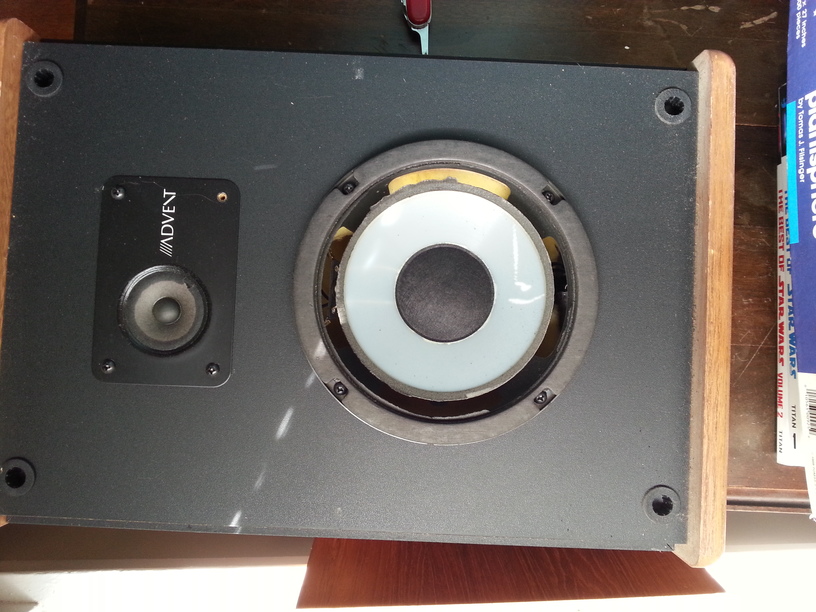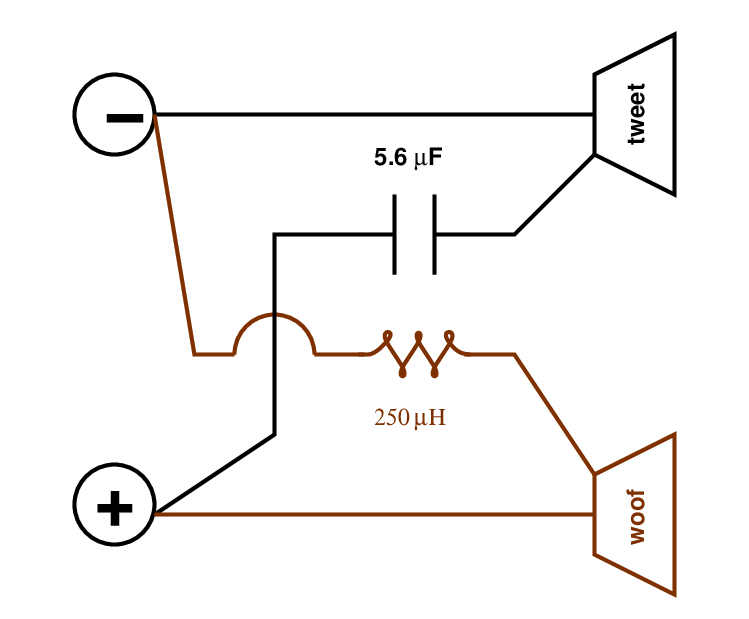
I recently purchased a pair of Baby Advent speakers for the small sum of $5. When I tested them at home, the good news was that they made musical sounds when connected to a receiver. The bad news was that the foam surrounding the woofers had decayed and would need to be replaced.
Take a look at the unit below.
The first step (after removing the grill) was to remove the gasket which holds the woofer to the cabinet. I loosened 4 screws and lifted them out, but the gasket was still stuck to the cabinet. I slid a thin plastic card under the gasket to loosen it gently, and eventually I could pull it off.
I pulled the woofer out of the cabinet.
Note the red dot next to one of the terminals, marking the positive lead. The wire running into this terminal has a faint blue stripe, which is hard to see. More on that later.
The wires can be removed from the terminals by pulling firmly (but gently). One was very tight -- I found the judicious use of a pair of pliers on the _base_ of the wire's connector to help.
In order to make sure that I could re-connect the wires to the proper terminals, I marked the wire running to the positive terminal (the terminal with a red dot) with some red ink.
The bottom face of the woofer -- the back of the driver -- features printed markings: "PLY 68". The side of the driver is marked "719832".
After removing the woofer, one can see the fiberglass insulation filling the cabinet.
Inside, at the lower end of the back wall, is the crossover circuit and connection to the outside world.
In order to reach the crossover, I had to remove the tweeter, too. So, I removed the screws holding it onto the cabinet, and (again using a thin plastic card) managed to separate the tweeter and its bracket from the cabinet.
Like the woofer, the tweeter has two terminals for wires from the crossover.
In this case, the two wires are easily distinguished, but there is no obvious mark on the tweeter's terminals. The key is to connect the wire with a red stripe to the terminal which is on the opposite side of the bracket from the word "Advent" printed on the front (see picture before picture above).
On the base of the tweeter's driver is printed "85C00015" and "K53TNJ".
After disconnecting and removing both the woofer and tweeter, one can carefully roll up slightly and then pull out the insulation. When inside the cabinet, the foam pad is curled inward on itself slightly, with the wires running on top of it (closer to the front of the cabinet).
Inside the back wall of the cabinet is a cryptic code: "BS 2 21 86". The first letter looks a bit like a cross between a capital "D" and capital "B". Does this mean the unit was created in 1986? Probably not, as I think Jensen purchased the Advent name in 1989.
Now, one can turn over the empty cabinet to unscrew and remove the section holding the exterior terminals.
This unit is labelled "Advent", but the name had been sold to International Jensen, Inc., by this time (late eighties). The serial number is "35228".
One can pull out the crossover circuit with the attached wires.
There are two inductors inside this giant blob of glue, with no markings I can see; and two components which I can identify:
The capacitor is a 3-microFarad, non-polar electrolytic unit rated to handle 100 volts. That is the item I could replace if desired.
On Sep 24, 2018, I tested this capacitor with a Fluke 187 multimeter while it was still connected to all the other components. I read a value of 3.1 microFarads across the capacitor, which seems to be close to the original spec. So -- don't bother to replace it?
I purchased a kit containing new foam surrounds and glue. Let's see if I can replace the foam on one of the speakers. Here's what it looks like at the start of the procedure:
Quite a bit of the old foam is still sticking to the outer edge of the cone, and to the metal gasket.
I scraped the foam off the gasket with an exacto knife. Some bits of glue remained --- oh, well.
The cone wouldn't take such rough treatment. I swabbed the edges of the cone with rubbing alcohol, waiting a minute or two, and then used my fingernail to scrape off the foam. I swabbed the edges of the cone with rubbing alcohol, waiting a minute or two, and then used my fingernail to scrape off the foam. Some of the disintegrated foam left black specks on the cone, but that shouldn't affect the sound.
I spread glue onto the inner edge of the new foam ring, and put some on the outer edge of the cone, too. I used a paintbrush to spread the glue over the surfaces.
Then I placed the new ring onto the cone and gently pressed the glued surfaces together. I waited 1.5 hours for this glue to dry.
Some guides mention that one should check at this point to see if the cone is off-center; if so, as it moves in and out, it can rub against its housing, creating a scraping sound. I did check, and didn't hear any scraping, but I'm not sure if it was necessary. I didn't see much freedom in the positioning of the cone.
The next step was to glue the outer edge of the new ring to the metal gasket which supports the woofer. This was tricky, because I had to lift up the edge of the ring and hold it up while applying the glue -- but I couldn't mis-center the ring during the procedure.
I let the glue dry for 24 hours.
The next day, it was time to put the woofer back into the cabinet.
I snipped away the foam from the regions around the screws, and affixed them. Voila!
The moment of truth: I hooked the newly refoamed speaker to my receiver. It was the right-hand speaker, and one of my decent Smaller Advent speakers was the left-hand speaker. Would the fixed-up Baby Advent perform as well?
In a word, "no." The Baby Advent sounded muffled and muddy. High notes were particularly missing, as they had been when I tested them right after my purchase a few weeks ago.
Replacing the foam did not fix the problem. Rats.
Suspicion fell (again) on the crossover circuit. I think it's time to try building a new one.
To start, I measured the resistance of each of the drivers individually. I had to open up the speaker and remove the wires from each one, but by this point, that went quickly. I measured:
The Baby Advent specs call for a crossover frequency of 4500 Hz. If we use a very simple, first-order crossover design like the one shown here, then we'll need
I decided to replace the crossover, in order to find out if the muddy sound was due to a problem with the electrolytic capacitors. My plan was to build a new, simple crossover circuit, on the plan below:

I purchased items from mouser.com
The first step was to remove the terminal block and attached crossover from the back of the speaker.
Here you can see clearly 2 of the 4 components on the back of the terminal unit: the 2-ohm resistor and 3 micro-Farad capacitor. There are a pair of inductors on the other side. All these components are attached to the unit by a clear glue.
I started by removing the resistor. The glue was surprisingly easy to remove with a sharp knife; it sort of peeled away in pieces.
Then I removed the other 3 components, leaving the back side of the terminal unit bare.
Note that the negative terminal is on the left, and positive on the right.
Here are the new components of my simplified crossover: the inductor at left, and capacitor at right.
I used a small bit of epoxy to hold the new components to the plastic unit, then started to solder the components into the circuit. First, the capacitor.
Next, the inductor.
After all the soldering was finished, it was time to put the terminal unit and crossover back into the cabinet. But, alas, I discovered at this point that my new components were a little bit too large to fit through the circular hole in the back of the cabinet. Arrgh!
I'll have to cut out a larger section of the cabinet in order to insert the new crossover. Sigh. It will mean losing one of screwholes, but I think only one.
For the moment, I just held the crossover into place with a bit of tape, and then connected the repaired speaker to my receiver. Would it sound better?
Alas, no. My notes state:
Double rats. I guess the crossover wasn't the problem, after all.
My current guess is that the tweeters on these Baby Advents aren't working properly. Perhaps I can replace them with some other tweeters.